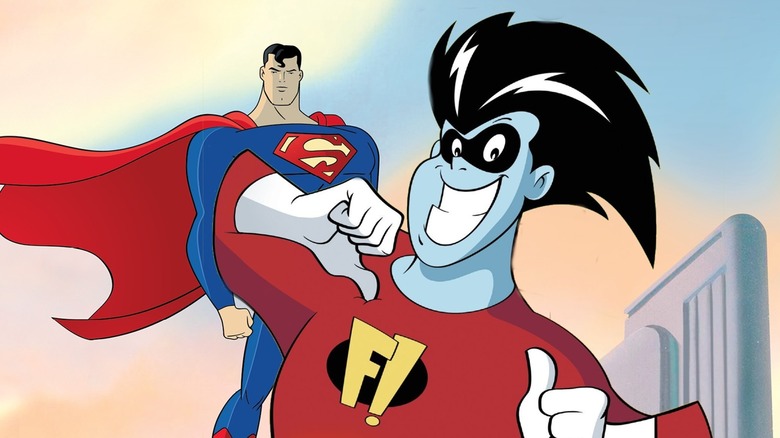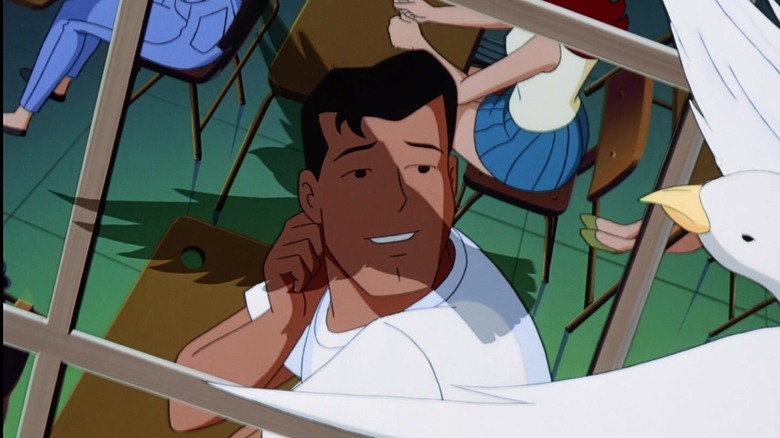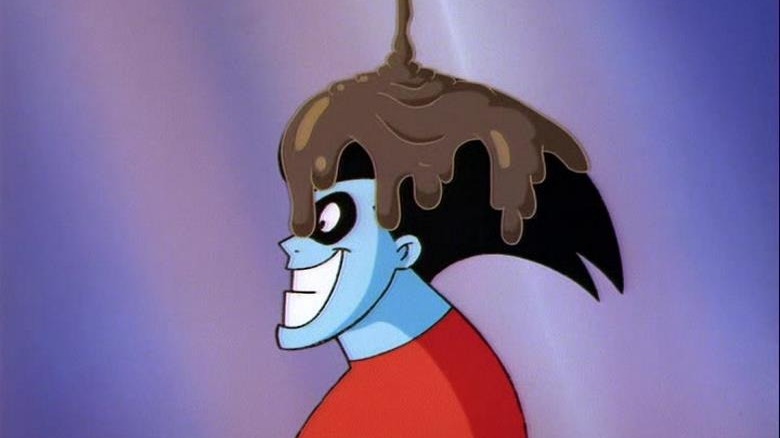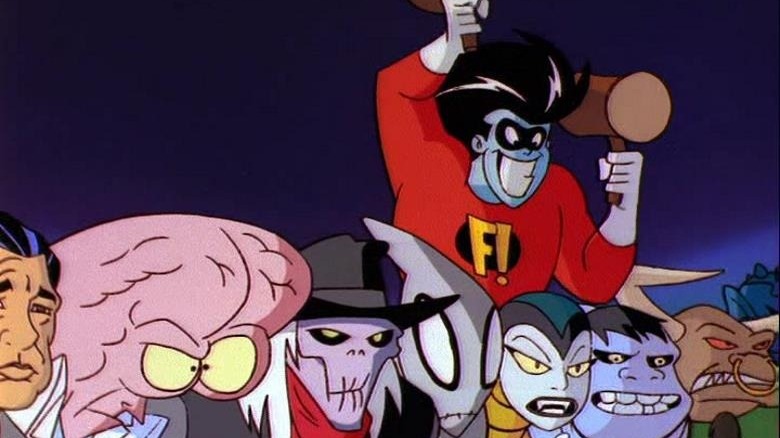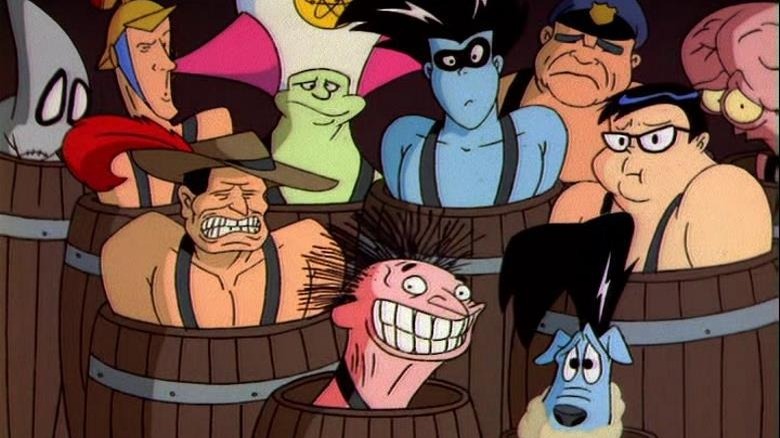The Road To Superman: The Animated Series Started With Steven Spielberg And Freakazoid!
"Superman: The Animated Series" occupies a curious middle ground in the DC Animated Universe, the continuity built by artists including Bruce Timm and Paul Dini. It never earned the rapturous critical reception of "Batman: The Animated Series," which to this day generates oral histories extolling its greatness. It also lacked the epic scope of "Justice League," which told multi-part stories featuring a huge cast of characters across time and space. But "Superman" should not be underestimated. At its best, the show's staff reinvented and condensed comics canon as elegantly as "Batman" did. Crossover episodes united Superman with Batman, Lobo and even Green Lantern, paving the way for the widescreen action of "Justice League." Best of all, "Superman: The Animated Series" introduced characters from Jack Kirby's Fourth World, including the nefarious Darkseid.
The DC Animated Universe ended in the early 2000s, but continues to influence contemporary animated series based on the characters to this day. Modern fan favorites like "Young Justice"and "Harley Quinn"could only thrive due to "Batman" and its successors paving the way. The canonization of the DC Animated Universe in the hearts of nostalgic millennials is such that it seems to have always been there in our hearts, the Platonic form of superheroes on TV. But this could not be further from the truth. "Batman: The Animated Series" only came about through a series of shocking coincidences, and "Superman" was no different. It all started with Bruce Timm, Steven Spielberg and a weird little show called "Freakazoid!"
Super-teen extraordinaire
Bruce Timm loved superheroes from the beginning. He also enjoyed drawing, but wasn't sure if he'd ever be good enough to make it as a comics artist. Per an interview with Comicology, he quit his "9-5 job at K-Mart" to work at nearby Filmation Studios. There he did layouts for "Blackstar" (in his own words, a "third-rate Conan knockoff") and eventually "He-Man: Masters of the Universe." In the process he met Russ Heath, a professional comics workhorse whose designs were unfortunately far too complex for animation. Timm respected Heath's craftsmanship, but aimed for a looser style that was easier to animate. He gained further experience and confidence drawing in-betweens for Don Bluth's "Secret of NIMH."
Timm found his way to Warner Bros just in time for "Tiny Toons Adventures." Producer Tom Ruegger hoped "to make Looney Tunes for the '90s," per the Los Angeles Times. "Tiny Toons Adventures" and its successor "Animaniacs" broke new ground for American TV animation, just as Disney's "DuckTales" had in 1987. Meanwhile, the success of Tim Burton's "Batman" film led the president of Warner Bros. Animation, Jean MacCurdy, to suggest a "Batman" animated series. Timm, who longed to sink his teeth into something meatier than "Tiny Toons," was immediately intrigued. He joined forces with a crew composed of "Tiny Toons" veterans and animation stalwarts including Paul Dini and Alan Burnett among others. They were united by their shared love of superhero comics and an ambition to expand the aesthetic and dramatic palette of TV animation. The rest is history.
He's here to save the nation
"Batman: The Animated Series" attracted many fans over the course of its run. One of them was Steven Spielberg, who had paved the way for the show's existence through Amblin Entertainment's animated co-productions. It was the success of Spielberg's "Who Framed Roger Rabbit" that had convinced Warner Bros to fund animated shorts and films in the first place. Per an interview with Bruce Timm at Comic Book Resources, Spielberg would tell MacCurdy that "I really like that Batman show ..." Timm, Dini and Burnett were soon called in to meet with Spielberg personally. The three of them drafted several pitches, floating them by Spielberg to gauge his interest. Spielberg went for "Freakazoid!," an action series about a teenager with superpowers.
The difference between "Freakazoid!" and "Batman" is clear from the very first episode. The "camera" pans through a familiar city cast in shadow and terrorized by supervillains. "Only one hero has the heart to fight this fiend," says the narrator. "That hero is ... on another network!" Batman shrugs from his home on Fox Kids. Kids' WB is stuck with Freakazoid, an annoying teenager who spent so much time on his computer that he transformed into an even more annoying superhero. "Freakazoid!" plays like an even wilder "Animaniacs," cramming every episode with pop culture references, non-sequiturs, and fourth-wall-breaking gags. The show lasted a meager two seasons, but those who clicked with "Freakazoid!" were forever changed. Its cult following includes Nathan Rabin and SlashFilm's own Witney Seibold, who claim the show predicted later Adult Swim fare like "Space Ghost Coast to Coast" and "The Venture Bros."
So stay tuned to this station
According to Timm in the Comicology interview, "Freakazoid!" began as an adolescent superhero story closer to "Spider-Man" in spirit. But it would not stay that way. "Every time we had a meeting with Steven," said Timm, "it kept leaning more & more towards zany comedy." Bruce Timm had enough of zany comedy back in the "Tiny Toons" days. Just like that, he was out. He appreciated the craft that went into "Freakazoid!" but his heart lay with the drama of "Batman." He gave the staff his blessing and jumped ship.
For a time, Bruce Timm had nothing to do. But fate broke in his favor once again. According to Comic Book Resources, Jean MacCurdy asked him one day if he would be interested in a Superman animated series. "Sure," Timm said, "I can start tomorrow!" Timm and his crew quickly discovered that Kids' WB was a far more hospitable environment for the dramatic superhero stories he craved than Fox Kids. "We couldn't believe our luck while working at Kids' WB that first season," he said. "These guys were letting us do whatever we wanted ..." "Superman: The Animated Series" begins with an ambitious three-part origin story whose first section ends with the complete annihilation of Superman's planet Krypton. Batman was never so lucky.
If not we'll be unemployed
Bruce Timm and his friends at Warner Bros. became successful because they were skilled, imaginative and hard-working. The truth, though, is that the DC Animated Universe came about not just because of them, but because of circumstance. Had the stars not aligned; had Tim Burton's "Batman" not been a hit; had Spielberg not been able to convince executives with "Roger Rabbit" that animation had legs; had Disney never invested in "DuckTales," "Superman: The Animated Series" might never have been made. "Freakazoid!" is a product of that same largesse, allowed to be wacky and experimental long before such a thing was marketable. The modern animation landscape is no different. "Adventure Time" is its own big bang birthed from many small coincidences.
We may be reaching the end of that window. Despite the success of animation during the coronavirus pandemic, the medium is now being hollowed out by the very corporations that relied upon it to keep the lights on. Ambitious animated works based on profitable existing properties, like the upcoming "Spider-Man: Across the Spider-Verse," might survive. But the Freakazoids of the world are in grave peril. Without a Jean MacCurdy or a Stephen Spielberg to count on, it's hard to know what the future may look like. But the next Bruce Timm is out there, somewhere. We just need to make sure they're in the right place at the right time.
